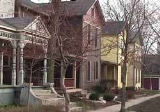
McPherson Town Historic District
Encyclopedia
The McPherson Town Historic District contains roughly 90 structures located on the north side of downtown Dayton
, Ohio
just on the other side of the Great Miami River
.
McPherson Town, and much of Dayton was devastated by the flood of 1897 and the Great Dayton Flood
of 1913. Many homes were destroyed or badly damaged. Current residents still find pounds of flood mud in walls and ceilings during renovation projects.
In the years following World War II
, Dayton citizens began their head-long flight to the suburbs, leaving an aging and declining inner-city, including McPherson Town. After years of neglect, the area was slated for bulldozing and urban renewal
. Residential property was purchased for speculative purposes, including commercial development, highrise condominiums and an interstate highway. But in the early 1970s, a few key private investors recognized the unique historical significance of the neighborhood and began to renovate several old homes. With this, a move to obtain historic district status began.
In August, 1977 Dayton declared McPherson Town its third historic neighborhood and structures were protected from future urban renewal efforts. In 1988, McPherson Town was registered on the National Register of Historic Places
, bounded by Main St., Great Miami River, and I-75 and Downtown Dayton (No. 88001712). City of Dayton Ordinance #25363.
Dayton, Ohio
Dayton is the 6th largest city in the U.S. state of Ohio and the county seat of Montgomery County, the fifth most populous county in the state. The population was 141,527 at the 2010 census. The Dayton Metropolitan Statistical Area had a population of 841,502 in the 2010 census...
, Ohio
Ohio
Ohio is a Midwestern state in the United States. The 34th largest state by area in the U.S.,it is the 7th‑most populous with over 11.5 million residents, containing several major American cities and seven metropolitan areas with populations of 500,000 or more.The state's capital is Columbus...
just on the other side of the Great Miami River
Great Miami River
The Great Miami River is a tributary of the Ohio River, approximately long, in southwestern Ohio in the United States...
.
History
Tucked into a corner of the horseshoe area formed by a bend in the Great Miami River, McPherson Town was founded on February 1, 1845. On this date, an Irishman named Samuel McPherson filed a plat consisting of 34 swampy, wooded lots on both sides of Dayton and Covington Turnpike. The center of this plat was located at the present day North Main St. and McPherson St.McPherson Town, and much of Dayton was devastated by the flood of 1897 and the Great Dayton Flood
Great Dayton Flood
The Great Dayton Flood of 1913 flooded Dayton, Ohio, and the surrounding area with water from the Great Miami River, causing the greatest natural disaster in Ohio history...
of 1913. Many homes were destroyed or badly damaged. Current residents still find pounds of flood mud in walls and ceilings during renovation projects.
In the years following World War II
World War II
World War II, or the Second World War , was a global conflict lasting from 1939 to 1945, involving most of the world's nations—including all of the great powers—eventually forming two opposing military alliances: the Allies and the Axis...
, Dayton citizens began their head-long flight to the suburbs, leaving an aging and declining inner-city, including McPherson Town. After years of neglect, the area was slated for bulldozing and urban renewal
Urban renewal
Urban renewal is a program of land redevelopment in areas of moderate to high density urban land use. Renewal has had both successes and failures. Its modern incarnation began in the late 19th century in developed nations and experienced an intense phase in the late 1940s – under the rubric of...
. Residential property was purchased for speculative purposes, including commercial development, highrise condominiums and an interstate highway. But in the early 1970s, a few key private investors recognized the unique historical significance of the neighborhood and began to renovate several old homes. With this, a move to obtain historic district status began.
In August, 1977 Dayton declared McPherson Town its third historic neighborhood and structures were protected from future urban renewal efforts. In 1988, McPherson Town was registered on the National Register of Historic Places
National Register of Historic Places
The National Register of Historic Places is the United States government's official list of districts, sites, buildings, structures, and objects deemed worthy of preservation...
, bounded by Main St., Great Miami River, and I-75 and Downtown Dayton (No. 88001712). City of Dayton Ordinance #25363.

